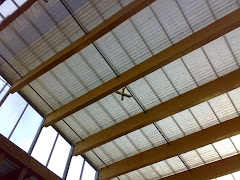Many years ago I was doing some work with a nail factory in Cardiff. The company, along with its sister steel companies, have, sadly, long since gone to the wall. I met and got to know some great people. This assignment was one of my first as a consultant - working then on Total Quality Management.
In the course of my work I talked about improvement and learning with a wide range of people in the firm. One man I worked with was the shop steward who had a wisdom and gentleness that I remember to this day.
He once told me story about the six inch nail machine. There was only one and it was a big machine, not surprisingly. Indeed the operator had a small raised platform on which to stand and keep the machine going. The task involved ensuring that the feed of steel rods into one end of machine was kept going smoothly while nails emerged from the other end. (My engineering knowledge is limited!) At various points during this process a button had to pressed near the hopper where the nails emerged and were collected. This button could not be reached from the raised platform. So several times each shift (perhaps even 50 to 60 times), the operator had to walk down the steps from his platform, walk around the machine and press the button. He then returned to his platform. It was a tedious part of the job. The man who operated the machine was a friend of the shop steward and had worked on that machine for over 20 years. He knew it well.
There was an occasion for the shop steward to work the night shift - something he very rarely did. On this occasion he happened to walk past the six inch nail machine and observed the night operator making it work. Everything was the same except at the point when the button needed to be pressed. Instead of walking down the steps and around the machine, the night operator picked a slighly odd shaped pole and used it to hit the button and the machine carried on operating. The shop steward looked on intrigued.
When he was next on the day shift, he went over to see his friend operating the six inch nail machine. He saw him working as normal. There came a moment when the button needed to be pressed and he said "stop" to his friend. The shop steward climbed the steps and asked his friend what the pole was for. His friend said something like:
"I don't know - it came with the machine when they delivered it way back" and shrugged his shoulders.
The shop steward showed him what the pole could be used for, having seen this on the night shift.
At this point, the shop steward observed (so he told me later) a dawning and excruciating realisation pass across the face of his friend as he mentally counted the times he had walked up and down the steps over the last 20 years or so. The learning was painful...
There are many lessons in here for me including communication, assured systems of work, induction & training etc etc. But what I want to focus upon is the idea that learning can yield huge amounts of pain.
If we learn something new - that upsets what we thought was reliable & true - there can be pain to be experienced. I am left wondering if we sometimes know this (perhaps subconsciously) and so we avoid learning - despite all the evidence and arguments to the contrary. We resolutely hold onto the past, because even though we know that there is a better way, it would mean experiencing such excruciating pain, that we would rather live in ignorance.
What do you think?
Letting go of old ideas & practises can be very, very difficult.









.jpg)


